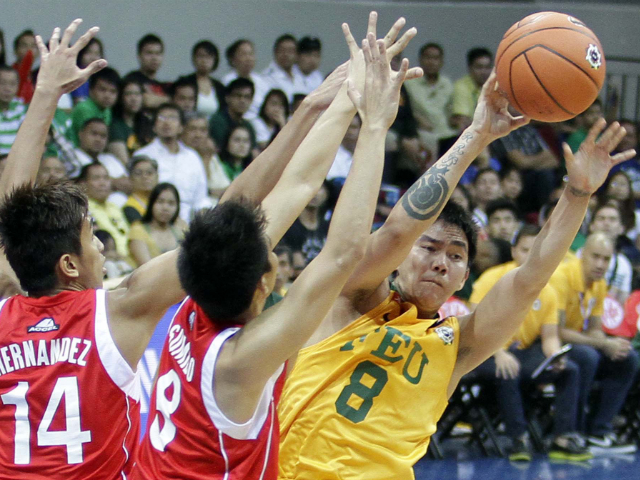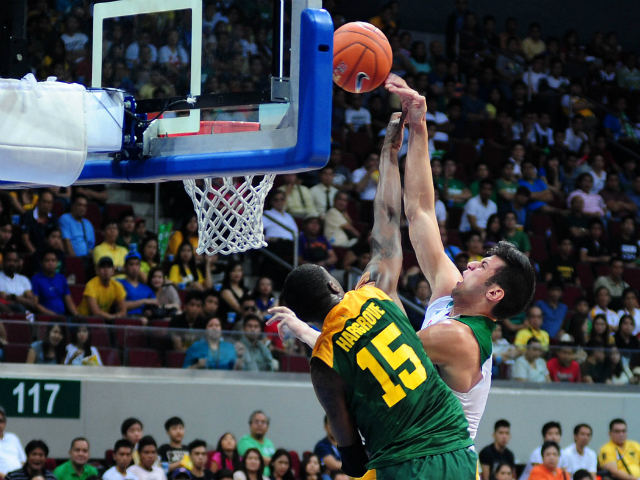Numerophilia: Are the FEU Tamaraws legitimate UAAP title contenders?
The FEU Tamaraws swept through the first round of Season 76 of the UAAP, finishing with a net efficiency of 9.5 points per 100 possessions. Such a stat begs the question – are the Tams the best team in the league? And are they serious title contenders?
A team’s net efficiency is usually a good indicator of how good the squad actually is. This was true last year, when the Ateneo Blue Eagles, sporting a net efficiency of 11.9 points per 100 possessions, won the crown. But FEU, with the third best net efficiency rating at 4.7 points per 100 possessions last year, didn’t get to compete in the Final Four because of their highly volatile offense that was dependent on perimeter shots (more than 54.3 percent of their shots) and a defense with holes inside and out (they allowed the third highest percentage of shots from both near the rim and from the three-point line).
Are they any different now?
While FEU is still a potent offense that relies on perimeter shots (60.7 percent of their shots come from the perimeter), they’ve beefed up their defense considerably.
FEU still ranks (far and away) as the best offensive team in the league, scoring almost 99.2 points per 100 possessions (the next closest team is NU, and they’re only at 92.9 per 100). Their defense however has been equally potent, allowing just 89.7 points per 100 possessions. That’s good for fourth, behind NU, Ateneo, and UST.
Interestingly enough, both their offense and defense rely on one thing: efficiency of shots. What does that mean? Read on.
Bombs away
FEU's offense largely revolves around the dribble drive offense. Because the shot creation comes all the way from the three-point line, attempts tend to come near that area, resulting in a perimeter attack.
On the surface, it's been working out well. The Tams make 32.1 percent of their shots from beyond the arc (league average is around 27.6 percent), and 38 percent of their midrange shots (league average is around 30.8 percent).

Three-point shots are a high-risk, high-reward proposition. You make one and you’re rewarded with three points. You miss and you get nothing. However, we know that you’re much more likely to be rewarded with nothing than be rewarded three points.
The same can be said about midrange jumpers. Though they're not as rewarding as three-point shots, you’re still far likely to miss than to make a shot. Of course, there comes a point when you have to take open midrange jumpers because that’s the only shot that you can get. But more often than not, mid-range jumpers are like fast food: There's nothing wrong with small doses, but large servings can be detrimental.
That should be a big red flag for FEU because the biggest reasons why their offense is chugging along at a neck-breaking efficiency are:
- They like to keep the ball in the hands of their brilliant trifecta of creators, Terrence Romeo, RR Garcia and Mike Tolomia. FEU turns the ball over on just 13.3 percent of their possessions, the best mark in the league by a large margin. That’s probably because they have few passes and therefore, fewer passes that can be stolen.
- That trio knows how to take and make threes (number one in percentage taken and percentage made).
Both of those can be maintained (especially in a season as short as the UAAP). But come the Final Four, when defenses tend to tighten up and easy shots are harder to find, that will be a big test to the Tams, especially with their volatile and “predictable” offense. To be fair though, among Romeo, Garcia and Tolomia, they’ll have enough shot creators to carry them through possible shooting droughts.
Defensive integrity
FEU's biggest problem will be once their defense starts showing signs of deterioration. Their defense has been good, but just like their offense, it has some serious red flags that the FEU coaching staff needs to address.
First and foremost, FEU’s defense relies largely on their ability to force opponents to miss. Among the four defensive factors, FEU is only above average (i.e. good) in one category – shooting defense. They can’t force turnovers (14.9 percent turnover rate), they can’t get defensive rebounds (defensive rebounding rate of 36.9 percent), and they give up a lot of free throws (22.9 percent free throw rate). So if they can’t prevent shots from going in at an excellent rate (which they’ve done so far in seven games, only allowing an effective field goal percentage of 38.5 percent), FEU is in trouble.
What’s even more worrisome for them is when you look into the shot selection that they force on their opponents, FEU’s season suddenly doesn’t look as pristine as their unblemished record. Nearly 80.4 percent of their opponent’s attempts come from the “good” shooting areas – near the rim and from the three point line. That’s the highest figure in the league.
Luckily for FEU, they’ve forced a good percentage of their opponent’s shots from those areas to miss. They’re conceding just 44.7 percent of shots near the rim and allowing just 22.6 percent of shots from the three-point line to go in.

What concerns me is when you talk about their interior defense. Outside of Christian Sentcheu, whom they can’t afford to play for more than a couple of minutes a game (he can't be on the court at the same time as Hargrove, and his defense doesn't make up for his lack of offense), they don’t have an excellent interior defender to make me believe that they can maintain their current defense. Anthony Hargrove, for all his athleticism, still misses rotations. Mac Belo and Carl Cruz, both sound team defenders, aren’t intimidators.
Like most, they may or may not maintain that number but I’m more skeptical on this one. And once their shot defense falls apart (if teams start making shots inside, FEU has to adjust, opening up the entire floor), their entire defense falls apart, an echo of last year (although not by that magnitude; I don’t see FEU NOT getting into the Final Four.).
Terrence Romeo the MVP
In our midseason Layup Lines, Romeo garnered a near unanimous vote as the MVP of round one. Most of us also agreed that Romeo was playing magnificently through seven games.
However, don’t mistake “playing magnificently” with “playing perfectly.” Yes, Romeo is playing brilliantly this season. He’s upped his rebounding from last season, and he’s almost maintained his efficiency while carrying a larger burden for his team. His assists rate also went up and he’s in fact gotten better at getting his teammates shots in the framework of FEU's offense
| Terrence Romeo | Season 75 | Season 76 |
| DRB% | 13.1% | 14.5% |
| Offensive rating | 102.1 | 97.3 |
| Usage rate | 28.6% | 38.1% |
| Assist rate | 21.2% | 30.3% |
| PER | 24.6 | 20.4 |
That said, some of his bad habits are still intact.
His helter-skelter dribbling, which allows him to separate himself from glue-like on-ball perimeter defenders, persists and it’s actually caused quite a few senseless turnovers (dribbling off his foot or out of bounds, losing the ball) and sometimes even costly ones (turnovers that lead to points or fouls from your teammates).

His love affair with the mid-range jumper still burns bright. I’ve discussed the importance and the effect of the midrange shot above. But with Romeo, it’s not a bad habit; it’s like alcohol and Romeo is fighting with the drunken fist technique, unpredictable and strong, but with a double edge.
The FEU Tamaraws are the team to beat only because they’ve yet to be beaten this season. Teams have come close, Ateneo, La Salle, Adamson and NU among others. But because of Romeo’s insane ability to hit in-your-face jumpers and the team’s game plan has yet to experience any significant hiccup.
However, seven games and two months is a long time. Some coaching staffs will find a way to exploit the things I pointed out here and (probably more), and if it will come at a key time (maybe in the Final Four or in the Finals), no one can tell. But if it does, the FEU faithful might say “we collapsed yet again!” when in reality, the teams’ success was never really on a solid foundation.
Are they contenders? Definitely. Are they the team to beat? Their unblemished record points to that. Are they the best in the UAAP? Hmmmmmmm. – AMD/HS, GMA News
Nico Baguio holds a Masters Degree in Mathematics from the Ateneo de Manila University. He's currently a writer for SBNation's At The Hive and runs a website that focuses on using advanced statistics on the local hoops scene, HumbleBola. You can email him at contact@humblebola.com. and also follow him on Twitter.



